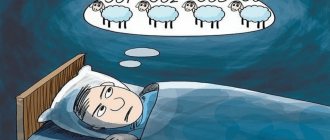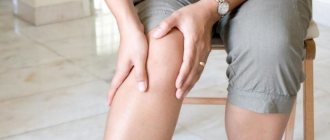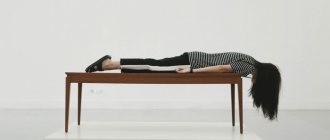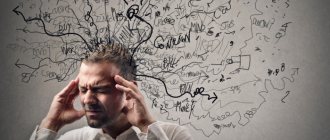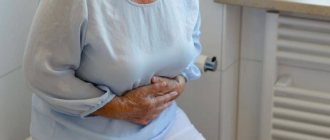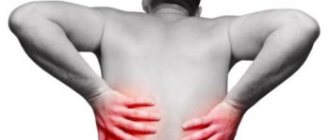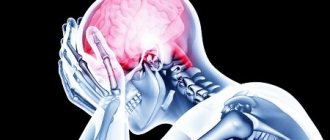In this article we will look at how to exercise when the sciatic nerve is pinched.
Quite often, patients experience pinching in the area of the sciatic nerve. The main reason for this spinal pathology is a sedentary lifestyle. Pinching is also common during high-intensity physical activity and during pregnancy. Sciatica (the correct name for pinched sciatic nerve) is accompanied by severe pain. The main method of eliminating the clamp is to perform special therapeutic exercises. Exercise plays an important role in the treatment of pinched sciatic nerve due to spinal hernia.
Symptoms
The most common symptoms of pinching are:
If such signs appear, you should immediately seek help from a doctor. In cases of severe pain, complex therapy is prescribed, which includes both taking anti-inflammatory drugs and performing special exercises.
When the inflammatory process is localized in the leg or thigh area, the patient is examined. Urine and blood tests are used as additional methods.
What does exercise mean when the sciatic nerve is pinched?
Clinical manifestations of sciatica
At the initial stage, unpleasant sensations only occur during coughing, laughing, sneezing or minor physical exertion. As the process progresses, the pain becomes more intense and bothers you during rest. Symptoms confirming inflammation of the sciatic nerve:
- Lerrey's symptom – the patient is unable to squat;
- Lasego symptom – the patient is unable to lift and straighten his leg;
- Sicard's symptom - pain intensifies when flexing the foot.
Associated symptoms appear:
- increase in body temperature from 38º;
- swelling in the back area;
- hyperemia of the skin on the lower back;
- decreased sensitivity (numbness) in the lower extremities;
- painful urination and defecation.
Exercises: basic complex for pinching
Stretching exercises are considered the most effective for unblocking a pinched nerve. This gymnastics is aimed at relieving inflammation and pain relief in the lumbar spine.
When performing therapeutic exercises, sudden movements should be avoided. All exercises are performed smoothly and measuredly, observing the rhythm and breathing cycle. It is necessary to stretch the muscles while exhaling. Basic exercises for exercises when the sciatic nerve is pinched include the following:
- Take a horizontal position with your leg bent. Pull your leg towards you, holding your knee, and fixate at the point of greatest muscle tension. Hold for half a minute. Extend your leg and repeat the cycle twice.
- Lying on the floor, bend your knees and pull them towards your chest. The affected leg should be on top of the healthy one. The legs are clasped with your hands and fixed for half a minute.
- Lie on your side, holding the toe of your sore leg. Pull your leg towards you as much as possible and try to reach your gluteal muscle with your heel. Hold in this position, then smoothly release your leg.
Treatment for a pinched sciatic nerve may require referral to a chiropractor or osteopathic specialist. When treating at home, it is necessary to take the necessary medications, carry out physical procedures and perform exercises.
Exercises from a sitting position
This set of classes includes exercises performed in a sitting position on the floor or on a chair.
Exercise 1
- Sit on the floor, bend your legs, and keep them in front of you.
- Place your right leg on your left thigh. You need to hold your left leg.
- Slowly turn your body and head to the right.
- Hold this position for 30 seconds.
- Repeat all steps for the second leg.
Exercise 2
- Sit on a stable chair.
- Place the ankle of your left foot on your right knee.
- Slowly and carefully lean forward. Make sure your back remains straight.
- Freeze in this position for half a minute.
- Repeat the exercise 5 times for each leg.
Exercises for pinched sciatic nerve according to Bubnovsky
When pinched, maximum effectiveness is achieved by performing a set of exercises proposed by Dr. Bubnovsky. Each exercise is performed 20 times, this is how you can achieve the maximum therapeutic effect:
- Arching the back with further relaxation. Performed standing on all fours. As you inhale, your back bends, and as you exhale, it slowly arches.
- Stretching. Also performed on all fours. The right leg must be stretched back. As you exhale, you need to lower yourself as low as possible.
- Sitting on all fours, bend forward.
- Strengthening the abdominal muscles. Lying on your back, bend your knees while lifting your body. Elbows should touch knees.
- Sit on your heels and rise as you inhale, stretching your arms in different directions.
- Cleansing breath. It is performed by exhaling air through tightly compressed lips. Hands are on the stomach.
- While on your knees, rotate your pelvis.
- Simple push-ups.
- In a sitting position, move on the muscles of the buttocks.
- Repeat push-ups.
- Standing on all fours, swing your legs forward and backward.
Water aerobics
Water aerobics is gaining the most popularity today. This version of gymnastics is suitable even for those who experience intense stress on the spine. Exercising in water significantly reduces the impact on the body. In addition, gymnastics with a ball is also used to relieve tension from the lumbar region.
Yoga
Yoga is also an effective way to relieve pinched sciatic nerves. With regular exercise, muscles become stronger and more mobile.
Other benefits of yoga include relieving muscle spasms, reducing the severity of pain, and normalizing blood circulation. The basis of the exercises is the correct implementation of breathing techniques. You need to breathe evenly and measuredly. A set of exercises is performed daily. You need to start with simple asanas (postures), gradually adding complexity.
Warm-up involves relaxing the muscles and preparing for the main complex. The best exercise for this is the “barrel” exercise, which involves arching and bending your back while standing on all fours.
The exercises should be performed during a period of low pain syndrome. The following complex is suitable for this:
- Lying on your back. The legs are bent and pulled towards the body. Hands clasp the gluteal muscles. Hold in the pose for half a minute, relax.
- Similar to the previous exercise, but the legs are pulled up to the chest one by one.
- Lying on your stomach, raise and lower your body as high as possible. The legs are pressed tightly to the floor.
- Lying on your back, tuck your legs and spread your arms behind your back. Touch your knees.
- In the previous pose, raise and lower the pelvis.
Yoga exercises used in exercises for pinched nerves in the lower back do not require special physical training, they are quite simple. However, beginners are advised to consult a specialist. The following conditions are contraindications for performing exercises:
In addition, yoga is not recommended during the postoperative period and during high-intensity pain syndrome. If discomfort occurs during training, you should abandon this type of gymnastics. So, how to do exercises when the sciatic nerve is pinched during pregnancy?
Physiotherapy
To prevent inflammation of the sciatic nerve, physiotherapeutic procedures are used:
- Vacuum massage – used to prevent back pain. The procedure enhances lymphatic drainage, improves skin elasticity and tones muscles.
- Paraffin treatment – applications have an anti-inflammatory and analgesic effect. A course of therapy restores the conductivity of the nervous system and relieves muscle spasms.
- Hydrotherapy – can also be used at home, the recommended temperature is 35–37°C. Water procedures promote relaxation and normalize sleep.
- Electrophoresis is a method of introducing medications into the back muscles that relieve pain, overstrain and promote tissue regeneration.
Pinched nerve during pregnancy
Against the background of prolonged stress during pregnancy, at the final stage of bearing a child, a woman may experience pinching of the sciatic nerve. The majority of drugs are prohibited during this period, so special exercises remain the only way out of this situation. There are several exercises that can be performed during pregnancy:
- Kneeling, place your hands on the floor. Your knees should be under your hips and your hands should be at shoulder level. The lumbar spine is arched and fixed for one minute, then a deflection is made and also delayed for some time. The head should be straight without bending.
- The previous exercise can be performed standing. To do this, place your feet hip-width apart and extend your arms forward for balance. The lower back arches and bends while fixing the pose for one minute.
- The foot is placed on a small stool or step, the body reaches towards it with the utmost care. When performed correctly, the exercise tightens the back muscles of the thighs. Stretching is done softly and smoothly. In a state of maximum tension, the posture is fixed. The back is straight, breathing is even.
If sciatica has not previously been observed, after childbirth you should consult a doctor and undergo an examination.
Exercise for a pinched sciatic nerve is within the power of everyone.
Prevention with vitamin therapy
Nerve fibers need nutrients contained in vitamin complexes. There are several groups of vitamins that help prevent inflammation of the sciatic nerve.
- Vitamin gr. A – retinol and carotene. The main functions are to improve sleep and stop the aging process of nerve cells. Regular use is a prevention of diseases associated with the central nervous system. Contained in carrots, apricots, butter, egg yolk, and Retinol acetate.
- Thiamine (gr. B1) – restores mental capacity and has a calming effect. A preventative measure consists of eating buckwheat porridge, rice and milk.
- Riboflavin (gr. B2) – helps cope with fatigue and relieve headaches. To prevent diseases of the nervous system, it is recommended to include nuts, dairy products and liver in the diet.
- Nicotinic acid (gr. B3, PP) – saturates blood vessels and improves its circulation. Preventive intake of these vitamins will help cope with depression and nervous pathology. Found in wheat, oats, nuts and beans.
- Folic acid (gr. B9) – eliminates feelings of anxiety and fear, gives the body strength. The vitamin is found in carrots, yeast and cauliflower.
- Ascorbic acid (gr. C) - taken for the purpose of prevention, increases the body's defenses and prevents the development of the inflammatory process. To replenish the supply, it is recommended to eat citrus fruits, cranberries, greens and rose hips .
Exercises for hernia
If sciatica occurs against the background of a vertebral hernia, it is necessary to select a special set of therapeutic exercises. Exercises in this case are performed lying on a flat, hard surface. You should not make sudden movements, as this can cause even greater compression of the nerves and blood vessels.
When doing exercises when the sciatic nerve is pinched due to a herniated disc, it is important to relax your back and stretch. The complex is based on the following exercises:
- Lying on your back, perform breathing techniques with deep, even inhalation and exhalation. Relax your back as much as possible.
- Pull your toes towards you as straight as possible.
- Legs are bent at the knees, feet pressed to the floor. The knees are slowly pulled up to the chest, the arms are clasped around the legs. The head is bent, the chin reaches towards the knees. The position is fixed for some time.
If you doubt the correctness of the exercise technique when the sciatic nerve is pinched by an intervertebral hernia, seek help from a specialist.
5.3. Basics of physical therapy techniques for diseases and injuries of the peripheral nervous system
The main importance in the functional therapy of trauma and disorders of the peripheral nervous system is the course of the nerve fibers that make up the pyramidal motor tract.
Its corticospinal fibers arise from motor cells in the motor zone of the cerebral cortex, pass through the white matter of the hemispheres, through the brain stem and, reaching the lower parts of the medulla oblongata, cross with the same pyramidal path on the other side, crossing the opposite side of the spinal cord.
Here it carries its endings, located around the motor cells of the anterior horns of the spinal cord. From these cells arise the nerve fibers of the peripheral neuron, which form the roots of the motor nerves and then the nerve trunk, which supplies the muscles with its branches.
Lesions of the anterior horns of the spinal cord, the motor roots extending from here and the processes that innervate the muscles, cause disorders of the motor apparatus, expressed in paralysis, paresis, and also manifested in a decrease in the strength of the corresponding muscles.
Such diseases include poliomyelitis, radiculitis, lesions of the motor roots, neuritis, polyneuritis, etc. The development of these disorders may be based on various reasons: trauma, hemorrhage, intoxication, infection, compression of the nerve roots by bone growths, etc.
A characteristic feature of movement disorders with lesions of the peripheral neuron are flaccid paralysis and paresis with decreased or complete absence of tendon reflexes, often with impaired skin sensitivity.
With traumatic neuritis, in addition to local damage to the nerve trunk, disturbances in the nerve roots, elements of the spinal cord, and functional disorders in the somatic and autonomic centers of the brain are also noted.
In neuritis, the lesion is localized in the peripheral nerve trunks of usually mixed nerves, as a result of which the main symptoms are paralysis or paresis of the peripheral type, corresponding to the muscular innervation of this nerve.
Flaccid paralysis, most often accompanied by muscle atrophy with a decrease or disappearance of tendon reflexes, with a decrease in muscle tone.
Along with impaired muscle function, skin sensitivity disorders may occur, and pain may appear when pressure is applied to the affected trunks and muscles when they are stretched.
Neurites come from different origins. The most common are traumatic neuritis. They occur with bruises in areas of the body through which nerve trunks pass, or with fractures of bones in the vicinity of which motor nerve fibers are located.
For neuritis, it is most often necessary to use complex treatment, an integral part of which is exercise therapy and massage. The forms of application of exercises and their ratio in the treatment complex are determined by the causes of the disease, its stage, form and characteristics of the course, as well as the individual characteristics of the patient.
In exercise therapy tasks
with damage to the peripheral motor neuron includes:
1) restoration of the functions of the nerve elements of the damaged neuron;
2) normalization of the activity of muscles innervated by the damaged neuron;
3) general strengthening effect.
Afferent stimuli arising at the time of passive or active movement serve as factors that pave the nerve paths, support their function, and coordinate the combined functioning of all nervous elements that have become disordered.
In addition, these impulses stimulate the regeneration of nerve conductors damaged by disease or injury. The fact is that due to axon degeneration and myelin breakdown, the conductivity of the nerve pathways is disrupted.
Performing physical exercises enhances metabolic (ionic) processes in the fiber, and impulses passing through it jump over the nodes of Ranvier - due to this, its conductivity increases. Such influences are especially effective in the early stages of illness or injury.
In those cases when a significant period of time has already passed, connective scar tissue begins to form at the site of the lesion and the regeneration of neuron elements becomes difficult; physical exercise, however, contributes to the partial resorption of this tissue and an increase in its elasticity.
The use of exercise therapy for traumatic neuritis is divided into two periods. In the early stages of the wound process, it is used to stimulate wound healing, improve circulation in innervated tissue areas, prevent complications, and the development of a rough scar at the wound site.
Among the preventive measures against complications that affect the functional state of the nerve and the muscles of other tissues innervated by it, one can include a light massage of parts of the limb after preliminary warming it up, which creates moderate hyperemia of the tissues surrounding the wound.
This improves circulation in the injured limb, reduces swelling and maintains tissue nutrition, and reduces irritation of nerve conductors.
Where the condition of the wound and pain disorders do not interfere with movement, you can begin therapeutic exercises from the first days after injury or surgery: passive and, where possible, active exercises, ideomotor efforts and sending impulses. When immobilizing the affected limb, physical exercises must be carried out for the healthy limb based on their reflex effect on the processes of blood circulation and nervous excitability in the diseased limb.
To restore the functional capacity of an injured nerve, stimulate the growth of nerve fiber, to bring the central nervous formations associated with the affected nerve to normal functional state, it is of exceptional importance to ensure a sufficient number of afferent impulses coming to the affected nerve from the periphery of the organ.
In those cases when the phenomena of paralysis prevail, and pain does not occur, or at the point when they no longer interfere with movement, it is necessary to begin active and passive gymnastics, paying attention to those exercises that correspond to the function of the affected muscle groups. The signs of fatigue or increased pain that appear in some cases after performing gymnastic exercises most often disappear under the influence of a subsequent, even short, thermal procedure.
In the case of reflex contractures, the first step is to remove the peripheral source of irritation, which is usually done surgically and conservatively.
Physical exercises used in this case actively help to reduce the excitability of the central reflex devices and reduce the tone of muscles in a state of spasm.
Depending on the timing of the development of spasm, movement treatment is combined with various orthopedic measures (fixing bandages, corrective operations, heat treatment, massage, etc.), the features of which should be taken into account in the construction of exercise therapy.
The effectiveness of exercise therapy for neuritis is determined not only by the correct selection and implementation of physical exercises, but also by the mode of their implementation.
It must fully comply with the relationship between the duration and intensity of the exercises; it requires the achievement of fatigue when performing each complex and a gradual increase in load.
Therefore, in the first period, with a complex duration of 10-15 minutes, it should be repeated at least six to eight times a day. During breaks between exercise therapy complexes, tissue massage (self-massage) is performed in the area of innervation of the damaged neuron for 10–12 minutes.
The second period of functional therapy of traumatic neuritis corresponds to the stage after wound healing.
It is characterized by the presence of late residual clinical phenomena, the development of scar tissue at the wound site, disturbances of blood circulation and trophism, the phenomena of paralysis, contractures and a pain-symptom complex.
As a result of rationally constructed and long-term exercise therapy, all these phenomena are eliminated (or at least alleviated) due to the normalization of nutrition of the tissues innervated by the affected nerve, the restoration of blood circulation in them with the active removal of residual inflammatory products from the affected nerves themselves and surrounding tissues. A favorable circumstance in this case is that physical exercise helps strengthen the paretic muscles , articular capsules and ligamentous apparatus, maintain joint mobility and their functional readiness for the moment of restoration of the nervous system.
In the second period, the duration of the exercise therapy complex gradually increases to 30–40 minutes, and its repetition is two to three times during the day. The duration of the massage (self-massage) can reach 20 – 30 minutes.
As an example of the use of exercise therapy for neuritis, let us consider the relatively common neuritis of the facial and sciatic nerves.
Neuritis of the facial nerve
It is manifested mainly by paralysis of the facial muscles of the affected side of the face: the eye does not close or does not close completely, the blinking of the eyelids is impaired, the mouth is pulled to the healthy side, the nasolabial fold is smoothed, there is no movement of the lips in the direction of the neuritis, the corner of the mouth is lowered, wrinkling of the forehead is impossible, the patient cannot frown. Depending on the severity of the neuritis, it lasts from two weeks to many months and does not always end with complete recovery.
The causes of neuritis are various lesions of the nerve as it passes through the canal of the pyramidal part of the temporal bone, inflammatory processes in the middle ear, intoxication, infections, postoperative and surgical complications.
The course of neuritis of the facial nerve is accompanied by a complication such as contracture of the facial muscles of the affected side, when the corner of the mouth is pulled to the affected side, the nasolabial fold becomes deeper, the palpebral fissure narrows, remaining half-closed, and facial asymmetry becomes more pronounced.
Both contracture and concomitant movements interfere with facial movements and aggravate the severity of paralysis.
The treatment complex for neuritis of the facial nerve is combined and includes drug therapy, exercise therapy with massage and physiotherapy.
Physiotherapy.
At the onset of the disease, it is of particular importance to ensure adequate afferent impulses from the periphery, thanks to which the conductivity of nerve fibers is maintained and the preservation of motor skills of the facial muscles is stimulated.
To do this, it is recommended to use passive exercises and a special massage of the entire face and neck using light stroking, light rubbing and, finally, vibration along the nerve branches with your fingertips.
The complex of physical exercises includes special exercises in wrinkling the forehead by raising the eyebrows, moving them (furrowing), blinking eyelids, baring teeth and folding lips to whistle, puffing out a sore cheek, etc.
The exercise therapy regime requires repeated use of physical exercises throughout the day, in particular those performed independently by the patient.
However, there is a danger that independent exercises in facial gymnastics in front of a mirror are not always performed correctly (for example, when practicing closing the eyes in the presence of paralysis of the lower eyelid, the patient tries to close it by supporting the eyelid by tightening the angle).
At the same time, as a result of repeated exercises, a stable perverted conditioned reflex connection is organized to perform a friendly movement. Therefore, it is extremely important to teach the patient to independently correctly perform corrective exercises.
When independent facial movements (or at least manifestations of minimal contractile activity) appear in any facial muscle, the main emphasis should be transferred from passive exercises to repeatedly repeated active efforts on the part of this particular muscle.
Causes of sciatic nerve neuritis
can be very diverse - infections, metabolic disorders (gout, diabetes), injuries, cooling, spinal diseases, etc.
When the sciatic nerve is damaged, sensory disturbances occur, paresis and muscle paralysis appear. If the damage to the nerve trunk is highly localized, the function of turning the hip outward, as well as flexing the shin towards the thigh, suffers, and walking becomes very difficult. With complete damage to the entire diameter of the nerve, loss of movement of the foot and toes is added.
If the peroneal nerve is damaged, the foot hangs flaccidly, and its outer edge droops. The patient's gait changes and becomes “horse-like” or “rooster-like.” At the same time, dorsiflexion of the foot and fingers, adduction and abduction of the foot are limited. In some cases, individual muscles may be affected, leading to deformation of the foot and its position.
Already during the period of keeping the patient in bed, care must be taken to prevent foot drop.
In addition to passive correction (in particular, using a splint that holds the foot in an average physiological position) and giving the knee and ankle joints a semi-bent position when lying on the side, passive exercises are used.
With the advent of active movements, special exercises are used in bending the lower leg to the thigh, rotating it outward, extending the foot and fingers, abducting it to the side and inward, and extending the big toe.
The effectiveness of therapeutic exercises increases with the use of a warming massage and a number of physiotherapeutic effects, mainly of a thermal nature, before the exercises.
In addition to increasing the elasticity of soft tissues and the articular-ligamentous apparatus, allowing movements with a greater amplitude, this measure reduces pain.
For the same purposes, thermal effects can be used after performing gymnastic exercises.
With tibial nerve paralysis, the ability to plantar flex the foot and toes is lost; the patient cannot stand on his toes, spread and bring his toes towards each other.
With paralysis of the tibial nerve, complications arise such as contractures and disturbances in the trophic tissue of the area innervated by the affected nerve (changes in the condition of the nails, hairy skin), vasomotor disorders manifested in the form of cyanosis, edema, etc.
The causes of most complications are the patient's prolonged stay in a protective anti-painful position or tonic contraction of the affected muscles, caused by prolonged irritation of the nerve innervating these muscles.
Therefore, from the very first day of illness, it is necessary to monitor the position of the patient’s body in bed, change his position from time to time without causing pain, and give him a position that ensures peace.
Considering these circumstances, the selection of means and methods of exercise therapy for lesions of the tibial nerve should be based on the need to increase the tone of muscles that are in a state of loss, and to decrease the tone of spasmodic muscles.
As with other types of lesions of the peripheral nervous system, in exercise therapy it is necessary to adhere to a dense, repeated and repeated regimen of using exercises.
In this case, you should carefully monitor the state of tone and activity of the affected muscles, and at the first signs of improvement in their condition, transfer an increasing part of the load to them, increasingly giving preference to active exercises over passive ones.
Source: //studfile.net/preview/2278853/page:51/



